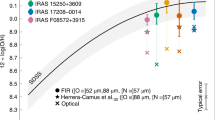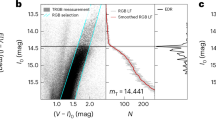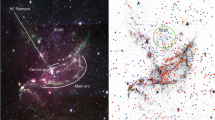Abstract
THE dominant feature in the UV spectra of reddened stars in our Galaxy is the broad absorption feature of interstellar origin, centred near 2,200 Å and having a halfwidth of 350 Å (ref. 1). The wavelength position of this feature and the correlation of its strength with other interstellar extinction parameters, for example, the visual colour excess E(B –V) are remarkably uniform throughout the Galaxy within 2 kpc from the Sun2. The 2,200 Å feature is attributed to small graphite spheres with radii between 100 and 200 Å (ref. 3), but a molecular origin cannot be ruled out4. It is, therefore, the most important feature to search for in the interstellar extinction laws of other galaxies. The Magellanic Clouds are the nearest extragalactic systems and the Large Magellanic Cloud (LMC), in particular the region near 30 Doradus, contains a significant amount of dust5. In the past few years considerable doubt has been expressed about the existence of the 2,200 Å feature in the LMC extinction law as derived from surface brightness measurements of the region around 30 Doradus6, the results being rather inconclusive due to the difficulties arising from uncertainties in the luminosity function for the region concerned7. The interstellar extinction law can be reliably determined only from studies of the individual spectra of reddened and unreddened stars of similar spectral types. We present here the UV observations of a moderately reddened and a slightly reddened early type supergiant in the LMC obtained with the IUE. These observations answer the question of whether or not the agents responsible for the 2,200 Å feature are present in interstellar dust in the LMC.
This is a preview of subscription content, access via your institution
Access options
Subscribe to this journal
Receive 51 print issues and online access
$199.00 per year
only $3.90 per issue
Buy this article
- Purchase on Springer Link
- Instant access to full article PDF
Prices may be subject to local taxes which are calculated during checkout
Similar content being viewed by others
References
Nandy, K., Thompson, G. I., Jamar, C., Monfils, A. & Wilson, R. Astr, Astrophys. 44, 195–203 (1975).
Nandy, K., Thompson, G. I., Jamar, C., Monfils, A. & Wilson, R. Astr. Astrophys. 51, 63–69 (1976).
Gilra, D. P. Scientific results from the OAO-2, 295–319 (NASA SP-310 1972).
Wickramasinghe, N. C., Hoyle, F. & Nandy, K. Astrophys. Space Sci. 47, L9–L13 (1977).
Feast, M. W., Thackeray, A. D. & Wesselink, A. J. Mon. Not. R. astr. Soc. 121, 337–385 (1960).
Borgman, J., van Duinen, R. J. & Koornneef, J. Astr. Astrophys. 40, 461–465 (1975).
Evans, R. G., Nandy, K. & Wilson, R. Phil. Trans. R. Soc. A 279, 473–477 (1975).
Boggess, A. et al. Nature 275, 372–377 (1978).
Boggess, A. et al. Nature 275, 377–385 (1978).
Sanduleak, N. Cerro Tololo Inter-American Obs. Contr. No. 89 (1969).
Rousseau, J. et al. Astr. Astrophys. Suppl, 31, 243–260 (1978).
Nandy, K. Highlights of Astronomy (ed. Müller E. A.) 4, 289–301 (1977).
Author information
Authors and Affiliations
Rights and permissions
About this article
Cite this article
NANDY, K., MORGAN, D. IUE observations of Large Magellanic Cloud members and detection of the 2,200 Å feature. Nature 276, 478–479 (1978). https://doi.org/10.1038/276478a0
Received:
Accepted:
Issue Date:
DOI: https://doi.org/10.1038/276478a0
This article is cited by
-
Interstellar extinction in the Large Magellanic Cloud
Nature (1980)
Comments
By submitting a comment you agree to abide by our Terms and Community Guidelines. If you find something abusive or that does not comply with our terms or guidelines please flag it as inappropriate.



